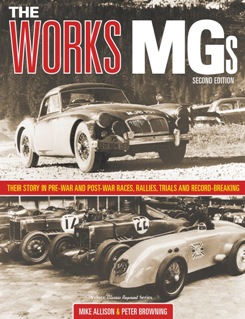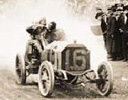Book Review
by Russell Jaslow
The Works MGs
(Second Edition)
by Mike Allison & Peter Browning
Veloce Publishing
ISBN: 978-1-787113-65-7. List Price: $65.00.
  To the American racing fan, MG is synonymous with the rebirth of sports car racing post-WWII. The MG road car had already been the favorite European car for returning GIs. When road racing resumed in 1948 at Watkins Glen, MGs dominated the entry list. To the American racing fan, MG is synonymous with the rebirth of sports car racing post-WWII. The MG road car had already been the favorite European car for returning GIs. When road racing resumed in 1948 at Watkins Glen, MGs dominated the entry list.
Throughout the history of SCCA racing, British sports cars were a favorite for drivers in the production classes, with MGs often topping the entries as well as results. Even today, Watkins Glen annually honors the marque during the U.S. Vintage Grand Prix and the downtown Grand Prix Festival.
Thus, anyone who wants to learn about the racing history of MG from 1924 to the closing of the works department in 1968 needs to get The Works MGs. The book is divided into two sections, each written by one author. And each tells the story of a different philosophy by the company towards motorsports.
Mike Allison, who worked as a technical specialist during the pre-war era, tells the tales of that period. Right from the start, MG did not want to create an official works racing program. Instead, they wanted to support private entries equally. MG felt it would be an unfair advantage to compete against their customers with a factory backed effort. Though at times, they pressed up hard against this self imposed line (especially for their land speed record attempts), for the most part, they kept to their belief. Cecil Kimber, founder of MG, even wrote a paper extolling this strategy. Thus, the exploits mentioned in the book are the private entries which MG supported.
It's interesting to note this philosophy is at times being followed today in various GT classes around the world, where manufacturers are no longer entering official works teams. Instead, they have setup customer entries who they support equally with parts, technical expertise, and development. Just like MG successfully did many decades earlier which helped support marketing their cars to the general public.
After the war, when various British car manufacturers found themselves under the British Motor Corporation, the BMC Competitions Department was formed. This time, official works teams were no longer taboo. Peter Browning, author of the second section, worked in this department and eventually became the manager until BMC decided to abandon racing completely and shut it all down.
Despite two different authors, their writing styles are so similar you barely notice the transition. Better yet, their writing style is easy to read, entertaining, and engrossing. They don't just rely on their own recollections. They use the stories, sometimes quoted verbatim, of the various participants. Not just the drivers, but the mechanics as well.
Though there is technical information and specifications, it's not laden with the nerdy stuff. However, it does have appendices which contains the nitty-gritty including official build sheets. The text instead concentrates more on the preparation for the events, the strategies, the events themselves, the human element, and the effects of those results.
This allows a perspective in what it was like getting ready for events and the races and rallies of the day. In many ways, it transports you back in time as if you are witnessing it all firsthand. Which makes it even more fascinating. (As an aside, the portion on Tazio Nuvolari's one drive in an MG is worth the purchase price alone. The insight you get into this man's methodical preparation, foresight, strategy, and car setup skills, even before you marvel at his driving skills, explains why he is considered one of the greatest of all time. It also demonstrates what separates the champions from the greats no matter what era they come from.)
All the while, you gain excellent knowledge and background into this important manufacturer's racing history. A history told with expertise. It's a worthy read, whether you are an MG fan or not.
Copyright © 2018 by . All Rights Reserved.
|



